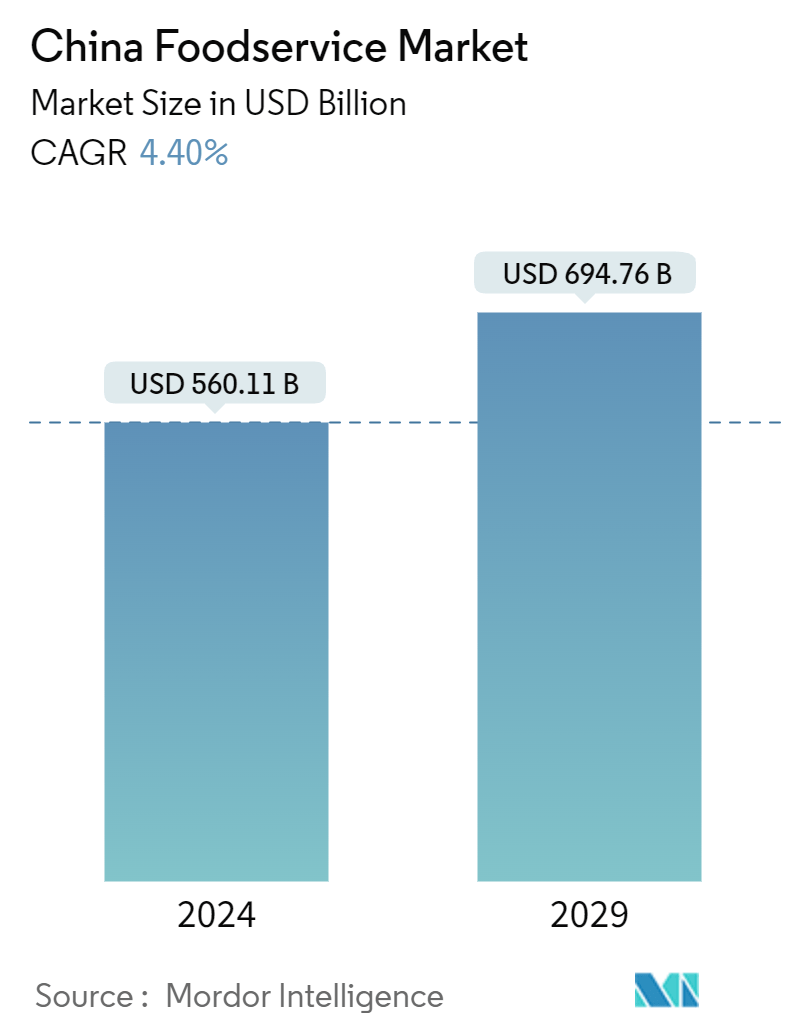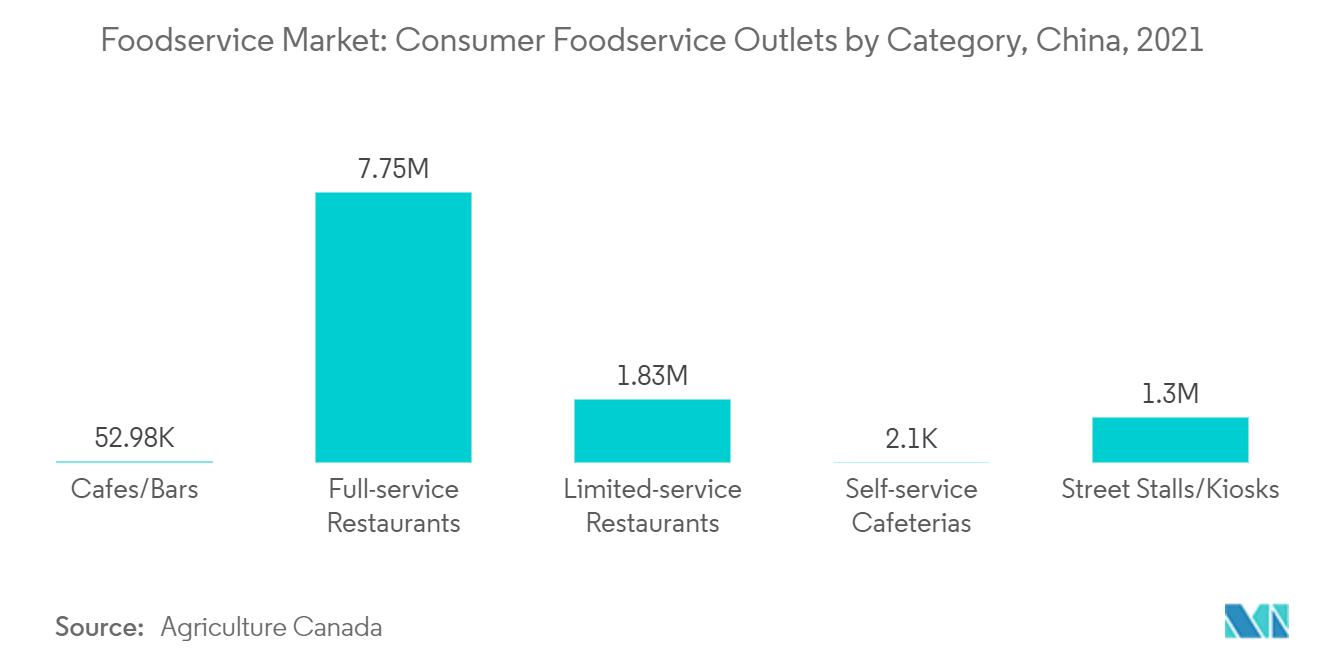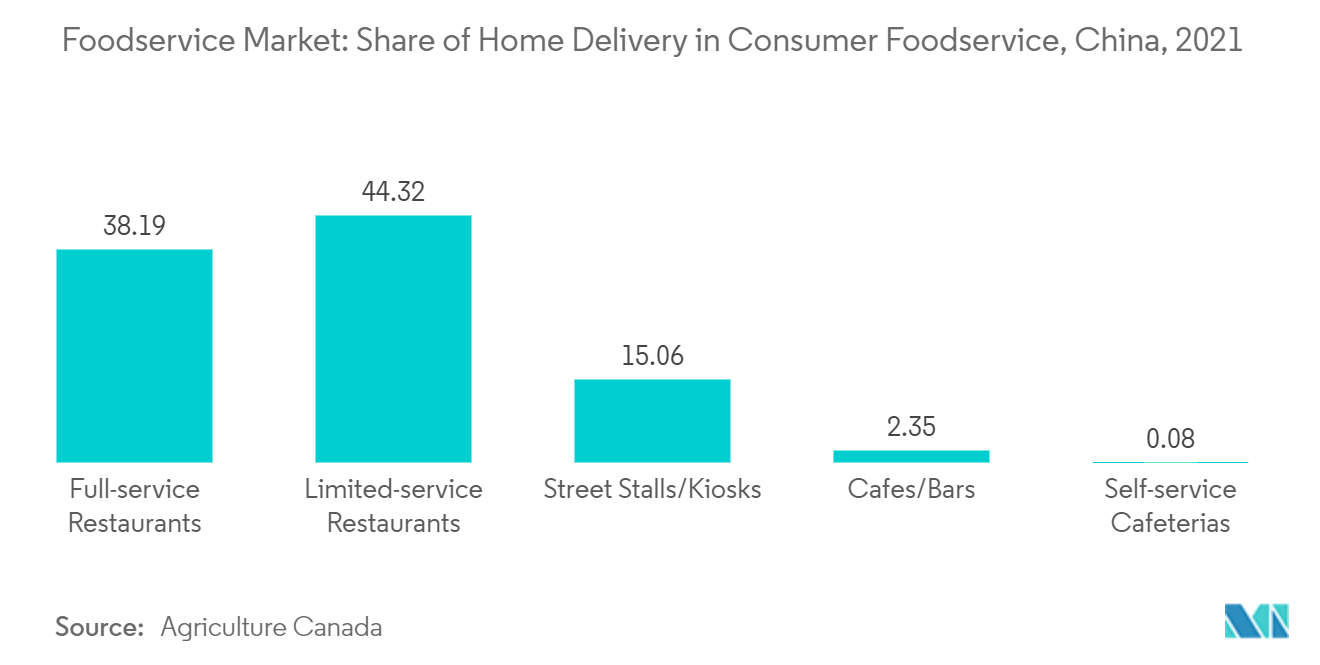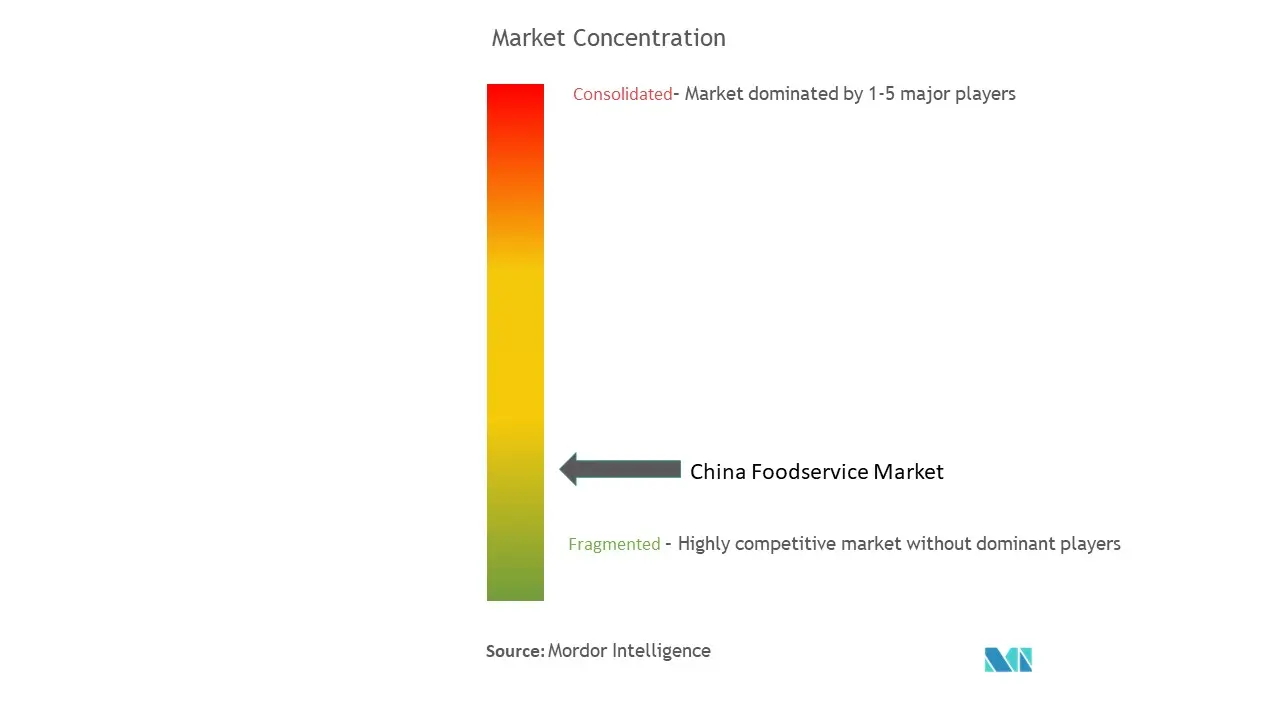China Food Service Market Size

| Study Period | 2019 - 2029 |
| Base Year For Estimation | 2023 |
| Market Size (2024) | USD 560.11 Billion |
| Market Size (2029) | USD 694.76 Billion |
| CAGR (2024 - 2029) | 4.40 % |
| Market Concentration | Low |
Major Players
*Disclaimer: Major Players sorted in no particular order |
China Food Service Market Analysis
The China Foodservice Market size is estimated at USD 560.11 billion in 2024, and is expected to reach USD 694.76 billion by 2029, growing at a CAGR of 4.40% during the forecast period (2024-2029).
China's foodservice market is primarily driven by the increasing frequency of dining out amid time-pressed schedules and the growing influence of Western dietary patterns, due to the presence of international companies particularly in urban areas. Additionally, the market is being driven by factors such as the growing percentage of the young and working population and the availability of organized food service restaurants offering quality food and services. Subsequently, the rapid growth of the fast-food sector in the country has led to an expansion of more food chains in the quick service sector, thus, benefitting the overall market studied.
As app-based delivery is growing in China, restaurants find it cheaper to service online from a cloud kitchen. Thus, the growing number of cloud kitchens in the country is further supporting the market studied. Furthermore, the market players in cloud kitchens are also incorporating new and innovative healthy food, with organic and natural ingredients, in an attempt to overcome the challenges previously faced by the players in the industry.
With digital natives contributing a larger share of transactions in the future, growth in the usage of technology in ordering and deliveries is inevitable is projected to record the fastest growth over the forecast period. Therefore, the above-mentioned factors are bound to support market growth during the forecast years.
China Food Service Market Trends
Augmented Demand for Vegan Food in Restaurants
Consumers in China are becoming more health aware that their needs for healthier substitutes for a wide range of consumer goods have strongly impacted the Chinese food and beverage sector. When China had less food security, meat was treated as the most important and famous eating food. But the times are changing, and Chinese people are noticing the negative side of eating an abundance of meat. Nowadays, health and weight concerns are the main reasons Chinese people reduce their meat intake and enhance the consumption of vegan food options in restaurants.
Although some European countries and the United States are showing faster growth, China is one of the largest consumers of vegan meat, representing about one-fourth of the world's market. The top-selling brand of plant-based meat La Mian Shuo collaborated with Vesta Food's brand HUICUI to introduce a plant-based pork option, and Nestle's Harvest Gourmet brand has also performed exceedingly well. They accounted for the highest number of sales in the plant-based meat sector. Thus, all such factors are supporting market demand and growth in the Chinese foodservice market.

Home Delivery Channel is the Fastest Growing Segment
Consumers have distinct regional and international food and flavor preferences in China. Restaurants in China serve local cuisines which dominate the market. However, western cuisines are becoming popular in Tier 1 cities. The demand for high-quality products is rising among consumers in China with increasing disposable income and the chain establishments have centralized purchasing points and now source ingredients from local distributors.
Furthermore, more affluent consumers in the country now spend more on dining out. Thus, upscale restaurant operators benefit from such consumer spending and more from the upliftment of travel restrictions in the country. Consumers are now opting to spend more money on premium dining for business and are paying for quality and international dining experiences.
Food delivery is also witnessing an increase as online ordering has reduced customer waiting time. The use of new technology is thriving in the Chinese food industry, with foodservice operators using e-menus, online reservations, mobile ordering, and payment apps. Many players in China are partnering with third-party websites, such as Ele.me, Fanting.com, and Waimaichaoren.com, which provide full menus from various restaurants and ordering and home delivery food services with the rise in the advent of digitalization. Independent restaurants offering home food delivery are also quickly gaining popularity in China, especially among busy urbanites, and may become an important service. Thus, all these factors are fueling market demand and growth in the Chinese foodservice market over the years.

China Food Service Industry Overview
The foodservice industry is rapidly growing in China. With its rising population, the foodservice operators are meeting new consumer demands as tastes are changing and becoming westernized, and new technology is being introduced to the foodservice industry. The Chinese foodservice market is highly competitive, with numerous local players. Some local players with a prominent market share are Xiao Wei Yang Chained Food Service Co. Ltd, China Quanjude (Group) Co. Ltd, Ting Hsin International Group, and Global players, such as Yum! Brands, Starbucks Corp, and Domino's Pizza Inc. hold a prominent market share.
China Food Service Market Leaders
-
Starbucks Corporation
-
McDonald’s
-
Domino's Pizza, Inc.
-
Yum! Brands Inc.
-
Restaurant Brands International, Inc (Burger King)
*Disclaimer: Major Players sorted in no particular order

China Food Service Market News
- In September 2022, McDonald's China opened a drive-through restaurant McDonald's Shougang Park in Beijing spanning nearly 650 sqm. As per the company's claim, it is the first leed-certified zero-carbon restaurant in the country that is designed and constructed per the Leed net-zero carbon and net-zero energy certification standards.
- In December 2021, Restaurants Brands International, Inc. announced a regional partnership with Ant Group to accelerate the digital transformation of its restaurant operations across Asia-Pacific.
- In October 2021, McDonald's announced its plan to test its first-ever plant-based burger, the McPlant, which it created with Beyond Meat Inc. in a strategic three-year partnership in China.
- In September 2021, Yum! Brands announced the completion of the acquisition of Dragontail Systems Limited (Dragontail), an AI-based innovative provider of technology solutions for the food industry, in accordance with Australian corporate law.
China Food Service Market Report - Table of Contents
1. INTRODUCTION
- 1.1 Study Assumptions and Market Definition
- 1.2 Scope of the Study
2. RESEARCH METHODOLOGY
3. EXECUTIVE SUMMARY
4. MARKET DYNAMICS
-
4.1 Market Drivers
- 4.1.1 Augmented Demand for Vegan Food in Restaurants
- 4.1.2 Growing Preference for Out-The-Home Consumption
-
4.2 Market Restraints
- 4.2.1 Increasing Demand for Ready Meals
-
4.3 Porter's Five Force Analysis
- 4.3.1 Threat of New Entrants
- 4.3.2 Bargaining Power of Buyers/Consumers
- 4.3.3 Bargaining Power of Suppliers
- 4.3.4 Threat of Substitute Products
- 4.3.5 Intensity of Competitive Rivalry
5. MARKET SEGMENTATION
-
5.1 Type
- 5.1.1 Full-Service Restaurants
- 5.1.2 Quick Service Restaurants
- 5.1.3 Cafes and Bars
- 5.1.4 Cloud Kitchen
-
5.2 Structure
- 5.2.1 Independent Outlet
- 5.2.2 Chained Outlet
-
5.3 Location (Quantitative Analysis Only)
- 5.3.1 ^ Standalone
- 5.3.2 ^Leisure
- 5.3.3 ^ Retail
- 5.3.4 ^ Lodging
- 5.3.5 ^ Travel
-
5.4 Cuisine Type (Quantitative Analysis Only)
- 5.4.1 Full Service Restaurants
- 5.4.1.1 ^ Asian
- 5.4.1.2 ^ European
- 5.4.1.3 ^ Latin American
- 5.4.1.4 ^ Middle Eastern
- 5.4.1.5 ^ North American
- 5.4.1.6 ^ Other Full-Service Restaurant Cuisine
- 5.4.2 Quick Service Cuisine
- 5.4.2.1 ^ Bakeries
- 5.4.2.2 ^ Burger
- 5.4.2.3 ^ Ice Cream
- 5.4.2.4 ^ Meat-Based Cuisine
- 5.4.2.5 ^ Other Quick Service Cuisine
- 5.4.3 Cafes and Bars
- 5.4.3.1 ^ Bars and Pubs
- 5.4.3.2 ^ Cafés
- 5.4.3.3 ^ Juices/Smoothies/Desserts
- 5.4.3.4 ^ Specialty Coffee and Tea
- 5.4.4 Cloud Kitchen (Overall Only)
6. COMPETITIVE LANDSCAPE
- 6.1 Most Adopted Strategies
- 6.2 Market Share Analysis
-
6.3 Company Profiles
- 6.3.1 Yum! Brands, Inc.
- 6.3.2 Restaurant Brands International, Inc.
- 6.3.3 McDonalds Corporation
- 6.3.4 Starbucks Corporation
- 6.3.5 Domino's Pizza, Inc.
- 6.3.6 Papa John's International Inc.
- 6.3.7 Inner Mongolia Xiao Wei Yang Chained Food Service Co. Ltd.
- 6.3.8 China Quanjude (Group) Co. Ltd.
- 6.3.9 Doctor Associates Inc.
- 6.3.10 Haidilao International Holding Ltd.
- *List Not Exhaustive
7. MARKET OPPORTUNITIES AND FUTURE TRENDS
** Subject To AvailablityChina Food Service Industry Segmentation
Foodservice refers to the preparation, distribution, and sale of food and beverages in various settings such as restaurants, cafeterias, and other establishments. The Chinese foodservice market is segmented by type, structure, location, and cuisine type. By type, the market is bifurcated into full-service restaurants, quick-service restaurants, cafes and bars, and cloud kitchens. Similarly, the market is segmented by structure into independent and chained outlets. The market is divided into standalone, leisure, retail, lodging, and travel based on location. Based on cuisine type, the food service market is segmented into full-service restaurants, quick-service cuisine, cafes and bars, and cloud kitchens and these are further bifurcated into Full-service restaurants (Asia, Europe, Latin America, Middle Eastern, North America, and other full-service restaurant cuisines), quick-service restaurants (bakeries, burgers, ice cream, meat-based cuisine, and other quick-service cuisine types), cafes and bars (bars and pubs, cafes, juices/smoothies/desserts, and specialty coffee and tea) and cloud kitchen respectively. For each segment, the market sizing and forecasts have been done based on value (in USD million).
| Type | Full-Service Restaurants | |
| Quick Service Restaurants | ||
| Cafes and Bars | ||
| Cloud Kitchen | ||
| Structure | Independent Outlet | |
| Chained Outlet | ||
| Location (Quantitative Analysis Only) | ^ Standalone | |
| ^Leisure | ||
| ^ Retail | ||
| ^ Lodging | ||
| ^ Travel | ||
| Cuisine Type (Quantitative Analysis Only) | Full Service Restaurants | ^ Asian |
| ^ European | ||
| ^ Latin American | ||
| ^ Middle Eastern | ||
| ^ North American | ||
| ^ Other Full-Service Restaurant Cuisine | ||
| Cuisine Type (Quantitative Analysis Only) | Quick Service Cuisine | ^ Bakeries |
| ^ Burger | ||
| ^ Ice Cream | ||
| ^ Meat-Based Cuisine | ||
| ^ Other Quick Service Cuisine | ||
| Cuisine Type (Quantitative Analysis Only) | Cafes and Bars | ^ Bars and Pubs |
| ^ Cafés | ||
| ^ Juices/Smoothies/Desserts | ||
| ^ Specialty Coffee and Tea | ||
| Cuisine Type (Quantitative Analysis Only) | Cloud Kitchen (Overall Only) |
China Food Service Market Research FAQs
How big is the China Foodservice Market?
The China Foodservice Market size is expected to reach USD 560.11 billion in 2024 and grow at a CAGR of 4.40% to reach USD 694.76 billion by 2029.
What is the current China Foodservice Market size?
In 2024, the China Foodservice Market size is expected to reach USD 560.11 billion.
Who are the key players in China Foodservice Market?
Starbucks Corporation, McDonald’s, Domino's Pizza, Inc., Yum! Brands Inc. and Restaurant Brands International, Inc (Burger King) are the major companies operating in the China Foodservice Market.
What years does this China Foodservice Market cover, and what was the market size in 2023?
In 2023, the China Foodservice Market size was estimated at USD 535.47 billion. The report covers the China Foodservice Market historical market size for years: 2019, 2020, 2021, 2022 and 2023. The report also forecasts the China Foodservice Market size for years: 2024, 2025, 2026, 2027, 2028 and 2029.
What are the emerging trends in the China Food Service Market?
The emerging trends in the China Food Service Market are a) Increasing popularity of casual dining experiences offering a balance between affordability and quality, catering to changing lifestyles b) Restaurants offering customizable menus, catering to diverse dietary needs and preferences
China Food Service Industry Report
The China food service market is on an impressive trajectory of growth, fueled by the increasing diversity in food service outlets from full-service to fast-food options that cater to both traditional preferences and a taste for novelty. Technological enhancements like e-menus and mobile ordering systems are streamlining operations and elevating the dining experience. Additionally, the popularity of theme-based establishments and the burgeoning coffee culture, led by giants such as Starbucks, are reshaping consumer expectations for leisure dining and premium beverages.This evolution is paralleled by a growing appetite for ready-made meals among the workforce, seeking both convenience and quality. Although the market faces challenges like a strong preference for local cuisines, it continues to flourish due to inventive marketing and a commitment to offering diverse and high-quality food choices. China food service companies are leveraging these trends to drive ongoing expansion and innovation in the sector. For detailed insights, Mordor Intelligence™ offers a comprehensive analysis, including market share, size, revenue growth rate, and a forecast outlook, available as a free report PDF download.



